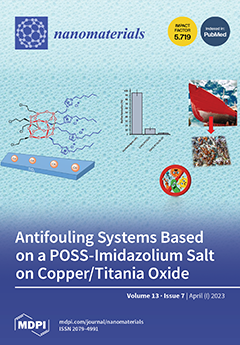Polyethylene oxide (PEO)-based composite polymer electrolytes (CPEs) containing in situ SiO
2 fillers are prepared using an electrostatic spinning method at room temperature. Through the in situ hydrolysis of tetraethyl silicate (TEOS), the generated SiO
2 nanospheres are uniformly dispersed in the PEO
[...] Read more.
Polyethylene oxide (PEO)-based composite polymer electrolytes (CPEs) containing in situ SiO
2 fillers are prepared using an electrostatic spinning method at room temperature. Through the in situ hydrolysis of tetraethyl silicate (TEOS), the generated SiO
2 nanospheres are uniformly dispersed in the PEO matrix to form a 3D ceramic network, which enhances the mechanical properties of the electrolyte as a reinforcing phase. The interaction between SiO
2 nanospheres and PEO chains results in chemical bonding with a decrease in the crystallinity of the PEO matrix, as well as the complexation strength of PEO chains with lithium ions during the hydrolysis process. Meanwhile, the addition of SiO
2 nanospheres can disturb the orderliness of PEO chain segments and further suppress the crystallization of the PEO matrix. Therefore, improved mechanical/electrochemical properties can be obtained in the as-spun electrolyte with the unique one-dimensional high-speed ion channels. The electrospun CPE with in situ SiO
2 (10 wt%, ca. 45 nm) has a higher ionic conductivity of 1.03 × 10
−3 S cm
−1 than that of the mechanical blending one. Meanwhile, the upper limit of the electrochemical stability window is up to 5.5 V versus Li
+/Li, and a lithium-ion migration number can be of up to 0.282 at room temperature. In addition, in situ SiO
2 electrospun CPE achieves a tensile strength of 1.12 MPa, elongation at the break of 488.1%, and it has an excellent plasticity. All in all, it is expected that the electrospun CPE prepared in this study is a promising one for application in an all-solid-state lithium-ion battery (LIB) with a high energy density, long life cycle, and high safety.
Full article






